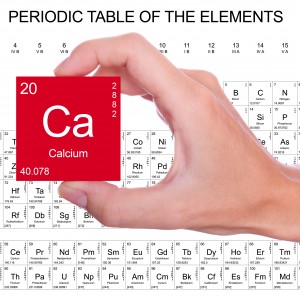Calcium (Ca): Essential for Plant Growth and Development
Cells are the smallest functioning component found in all living organisms. They play a valuable role in the development of all the numerous tissues and organs, which effectively make life possible. The development of all of these different apparatuses is directly linked to the health and quality of the cells involved. Every structure of a plant, inside and out, is the result of the collective teamwork of many tiny cells. In order for a plant to develop properly, the cells must be able to grow and reproduce in a healthy manner. To ensure that this happens to the greatest extent, each individual cell will need a reliable source of calcium (Ca) to help it grow and reproduce.
 Calcium was deemed an essential element for plant growth and development well over a hundred years ago and its importance has been heavily documented. As I stated earlier, calcium plays a large role in the development of growing plant cells, especially in the formation and stability of the cell walls. A cell wall that is strong and fortified will grow more uniformly and be more impervious to attacks from pests and disease. This is important in many aspects of a plants life. Calcium is immensely significant in the growth of all the parts of a plant and, if deficiencies occur, they will often show in the newest, youngest growth. A sufficient calcium supply, in conjunction with other essential nutrient elements, will lead to a more uniform development of shoots, leaves and flowers as well as a higher quality standard of fruits. Not only does calcium assist in cell wall fortification, it is also involved in the activation of several enzymes that aid in the division and reproduction of said cells.
Calcium was deemed an essential element for plant growth and development well over a hundred years ago and its importance has been heavily documented. As I stated earlier, calcium plays a large role in the development of growing plant cells, especially in the formation and stability of the cell walls. A cell wall that is strong and fortified will grow more uniformly and be more impervious to attacks from pests and disease. This is important in many aspects of a plants life. Calcium is immensely significant in the growth of all the parts of a plant and, if deficiencies occur, they will often show in the newest, youngest growth. A sufficient calcium supply, in conjunction with other essential nutrient elements, will lead to a more uniform development of shoots, leaves and flowers as well as a higher quality standard of fruits. Not only does calcium assist in cell wall fortification, it is also involved in the activation of several enzymes that aid in the division and reproduction of said cells.
In a soil or growing medium, calcium travels right along with water and its uptake by plant roots is directly affected by a plant’s transpiration rate and the level of moisture present in the soil. Certain environmental conditions, including high humidity and cold weather, will slow or even stop the evaporation of water vapor from a plant’s stomata, which causes what is termed a low transpiration rate. In plants, a low transpiration rate means that the roots will not be able to uptake water at a normal capacity. Since calcium travels into a plant via the water flow into the roots, a low or interrupted flow can result in inadequate levels of calcium being provided, leading to potential deficiencies. To maximize the availability and accessibility of calcium, it is important that a grower maintain proper soil moisture levels (never too wet or too dry) at all times. This will ensure a steady flow of calcium to all growing parts of the plant.
Once the calcium has entered the plant, it travels, with the water, mainly through the xylem. Upon arriving at its destined part of the plant, it will more or less stay there and do its work. Unlike other elemental nutrients, such as nitrogen (N), calcium is not very mobile once it is within the plant. What this means is that a plant cannot take calcium from a structure in one location and move it to another where it may be needed. This is why a constant supply of available calcium to the roots is so important, especially during vigorous growth periods. Without this steady supply, the development of new growth (including shoots, flowers and fruits) will be significantly hindered and lead to many unwanted problems, such as severely stunted and abnormal growth.
Calcium deficiencies can present themselves visually in several different ways. The most commonly recognized symptom by vegetable growers is likely the Blossom End Rot (BER) of tomatoes. BER is the rotting of the bottom end of a tomato, caused by the collapse of the cell walls. A lack of calcium causes the decay of that part of the fruit. However, a calcium deficiency can also be recognized in earlier stages of development, before fruits even start to develop. The actively growing parts of the plant, such as new leaves, will experience a severe disruption in their development. Due to the unavailability of calcium, the edges of the leaf will not grow as quickly as the centralized parts, deforming the leaf and causing it to cup downwards. Calcium deficiency can also result in the “tip burn” of the more mature, but still growing leaves. The improper development of flowers can lead to flower abortion (drop off) and an overall drop in the production and quality of fruit.
Elemental nutrient deficiencies can occur for a few different reasons. An acute deficiency occurs when a certain element has been depleted and is no longer available in the rooting medium or was not present to begin with. A chronic deficiency is the result of an element being available to the plant, but in small amounts, which are insufficient for optimal growth. Calcium deficiencies can occur both of these ways. However, they can also develop due to improper watering techniques. As was stated earlier, calcium travels directly with the water entering the roots and is essential for the development of every part of the plant. If a grower’s watering technique is inconsistent and the plant encounters drastic changes in the level of root zone moisture, going from extremely wet t to dry, the flow of calcium into the roots and to all of the growing parts of the plant will be inconsistent as well. This inconsistency in the flow of available calcium can lead to unwanted calcium deficiencies, even though there may already be a plentiful supply available to the roots. Steady, consistent watering is key to optimizing calcium uptake. Also, utilizing an irrigation method such as “drip-line” irrigation can help a grower achieve this goal.
Other factors that may affect the availability of calcium deal directly with the physical make-up of the soil or rooting medium. Calcium in the soil exists as a positively charged ion (cation) and will be attracted and held by negatively charged particles in the soil, such as organic matter and clay. The negatively charged soil particles not only hold on to the positively charged cations, they can also exchange them for other cations nearby in process quantified as a soils cation exchange capacity. Soils with high levels of clay or organic matter content will hold on to and systematically release calcium cations, maintaining a more consistent availability of the element. In soils that contain a more prominent amount of inorganic material, such as sandy soils, the cation exchange rate will be much lower as there is little in terms of negatively charged particles to hold onto to cations. In conditions such as this, calcium can be easily leached from the soil or medium with a mass flow of water, severely affecting the amount available to the plant. Other elements that participate in the cation exchange process include magnesium (Mg) and potassium (K). If these elements are not in balance within the soil, it can result in a deficiency of one of them. The ammonium (NH4) cation can also be extremely competitive with the calcium cation and can lead to a calcium deficiency. One more factor that can negatively impact calcium availability is soil pH. A soil with a pH above 7.5 can cause the calcium ions to become tied up with other elements, which forms an insoluble compound that is not available for consumption by the roots. This will lead to a limiting in the availability of both elements. Generally speaking, maintaining a desired soil pH with applications of agricultural lime should supply enough calcium to meet the needs of most plant species.
Calcium fertilizers are available in several forms. The forms range from inorganic to organic. Inorganic forms contain nitrate nitrogen (N), which are often in levels that are undesired and can adversely affect growth. The organic forms can include agricultural limestone, calcium carbonates and calcium sulfate. It is also important to remember that plants vary from species to species regarding calcium requirements, so a grower should research the calcium requirements of the specific plant being grown. Before applying any calcium supplement, a grower should first research the nutritional needs of the crop being grown to assure that the amount applied will not cause an excess to accumulate. It may be wise for a grower to have a sample of the soil analyzed to see exactly what it contains (applying to much fertilizer can be just as bad as not applying enough).
A smooth flowing, constant supply of calcium is essential in the development of healthy productive plants that make it successfully through all cycles of growth. From seed to harvest, a good grower never lets their plants down. Providing a sufficient supply of calcium is an important step for success.


